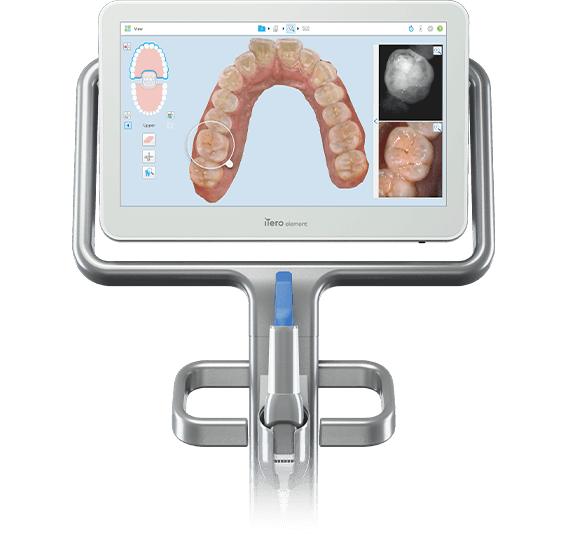Traditionally, dental impressions were crafted using putty-like materials to form molds of your teeth and gums. While this method is still employed in many dental offices, some have evolved to adopt cutting-edge technology, utilizing digital scanners to produce precise 3D scans of your teeth and gums. In this post, our Fairview dentist will shed some light on the benefits of an Invisalign scan, how this type of digital scanning technology works, and what to expect during the process so that you can take charge of your oral health for that perfect smile.

An Invisalign scan is a state of the art technology used to capture digital images of someone’s teeth and create a detailed treatment plan for orthodontic treatment. This advanced scanning process uses 3D imaging to help create custom-fit aligners designed to perfectly fit over the individual’s teeth and move them into their desired position. The scan can provide the dentist with pictures of the person’s mouth and detailed information about how their teeth need to be moved to achieve the best results from their treatment. By using this technology, dentists can provide faster and more precise treatments that result in better outcomes for patients who require orthodontic care.
Patients who choose this orthodontic treatment have the advantage of being able to use digital technologies and tools that are designed to give them accurate results. With a digital impression or intraoral scanner, Align Technology provides precise measurements for creating custom aligners. This method is more comfortable for patients and more efficient than traditional methods. As a result, patients can get their desired results faster and with less hassle.
The first step to your invisalign treatment is to take a detailed 3D image of your teeth and jaw with the iTero scanner. This digital scan is a goop-free dental scan that produces high-definition and high-resolution photos.
Using the the iTero Scanner, your dentist will gently move it in front of your mouth and jaw, capturing numerous images of your teeth. The interactive image allows for a close inspection of your teeth and jaw structure, helping to create an accurate treatment plan. Once your scan is complete, the dentist can review the interactive 3D model to make any necessary adjustments before beginning treatment with Invisalign aligners.

Once the scan is complete, your next step will be to discuss with your doctor the adjustments that need to be made before beginning treatment. As part of the Invisalign process, your dentist will review the digital scan and use a 3D treatment planning process to decide what custom aligners are best for you. In addition, your dentist will also review the financial details of your treatment plan, including the cost of the aligners, any insurance coverage, and available payment options. This ensures that you clearly understand the financial aspect of your Invisalign journey, allowing you to make informed decisions about your oral health.
Two main types of impressions are used—digital and physical. Digital impressions use a scanning device, like an iTero scanner, to capture real time images of your teeth, while putty dental impressions involve pressing gooey material against your teeth to create a mold. Both are accurate and reliable ways of creating an impression of your mouth before getting fitted with Invisalign. However, digital impressions are often faster and more accurate than putty dental impressions, making them more convenient for busy patients who want to get Invisalign as quickly as possible. Ultimately, both options work, although most patients will generally prefer digital impressions vs traditional impressions.

At Sloan Creek Dental, you can take comfort in knowing that we’re dedicated to providing you with the most advanced and cutting-edge technology for your orthodontic care. When you embark on your Invisalign journey at our office, you won’t have to endure the discomfort of those outdated, messy impressions from the past. Instead, you’ll enjoy the ease and precision afforded by the state-of-the-art iTero Element digital scanner, ensuring your experience is both comfortable and highly accurate.
If you’re in the Fairview Allen area and want to straighten teeth for a beautiful smile, contact us today to see if Invisalign clear aligners is for you can contact us at our Fairview, TX dental office to schedule your initial consultation at 972-468-1440.
We firmly believe that the internet should be available and accessible to anyone, and are committed to providing a website that is accessible to the widest possible audience, regardless of circumstance and ability.
To fulfill this, we aim to adhere as strictly as possible to the World Wide Web Consortium’s (W3C) Web Content Accessibility Guidelines 2.1 (WCAG 2.1) at the AA level. These guidelines explain how to make web content accessible to people with a wide array of disabilities. Complying with those guidelines helps us ensure that the website is accessible to all people: blind people, people with motor impairments, visual impairment, cognitive disabilities, and more.
This website utilizes various technologies that are meant to make it as accessible as possible at all times. We utilize an accessibility interface that allows persons with specific disabilities to adjust the website’s UI (user interface) and design it to their personal needs.
Additionally, the website utilizes an AI-based application that runs in the background and optimizes its accessibility level constantly. This application remediates the website’s HTML, adapts Its functionality and behavior for screen-readers used by the blind users, and for keyboard functions used by individuals with motor impairments.
If you’ve found a malfunction or have ideas for improvement, we’ll be happy to hear from you. You can reach out to the website’s operators by using the following email
Our website implements the ARIA attributes (Accessible Rich Internet Applications) technique, alongside various different behavioral changes, to ensure blind users visiting with screen-readers are able to read, comprehend, and enjoy the website’s functions. As soon as a user with a screen-reader enters your site, they immediately receive a prompt to enter the Screen-Reader Profile so they can browse and operate your site effectively. Here’s how our website covers some of the most important screen-reader requirements, alongside console screenshots of code examples:
Screen-reader optimization: we run a background process that learns the website’s components from top to bottom, to ensure ongoing compliance even when updating the website. In this process, we provide screen-readers with meaningful data using the ARIA set of attributes. For example, we provide accurate form labels; descriptions for actionable icons (social media icons, search icons, cart icons, etc.); validation guidance for form inputs; element roles such as buttons, menus, modal dialogues (popups), and others. Additionally, the background process scans all of the website’s images and provides an accurate and meaningful image-object-recognition-based description as an ALT (alternate text) tag for images that are not described. It will also extract texts that are embedded within the image, using an OCR (optical character recognition) technology. To turn on screen-reader adjustments at any time, users need only to press the Alt+1 keyboard combination. Screen-reader users also get automatic announcements to turn the Screen-reader mode on as soon as they enter the website.
These adjustments are compatible with all popular screen readers, including JAWS and NVDA.
Keyboard navigation optimization: The background process also adjusts the website’s HTML, and adds various behaviors using JavaScript code to make the website operable by the keyboard. This includes the ability to navigate the website using the Tab and Shift+Tab keys, operate dropdowns with the arrow keys, close them with Esc, trigger buttons and links using the Enter key, navigate between radio and checkbox elements using the arrow keys, and fill them in with the Spacebar or Enter key.Additionally, keyboard users will find quick-navigation and content-skip menus, available at any time by clicking Alt+1, or as the first elements of the site while navigating with the keyboard. The background process also handles triggered popups by moving the keyboard focus towards them as soon as they appear, and not allow the focus drift outside of it.
Users can also use shortcuts such as “M” (menus), “H” (headings), “F” (forms), “B” (buttons), and “G” (graphics) to jump to specific elements.
We aim to support the widest array of browsers and assistive technologies as possible, so our users can choose the best fitting tools for them, with as few limitations as possible. Therefore, we have worked very hard to be able to support all major systems that comprise over 95% of the user market share including Google Chrome, Mozilla Firefox, Apple Safari, Opera and Microsoft Edge, JAWS and NVDA (screen readers), both for Windows and for MAC users.
Despite our very best efforts to allow anybody to adjust the website to their needs, there may still be pages or sections that are not fully accessible, are in the process of becoming accessible, or are lacking an adequate technological solution to make them accessible. Still, we are continually improving our accessibility, adding, updating and improving its options and features, and developing and adopting new technologies. All this is meant to reach the optimal level of accessibility, following technological advancements. For any assistance, please reach out to